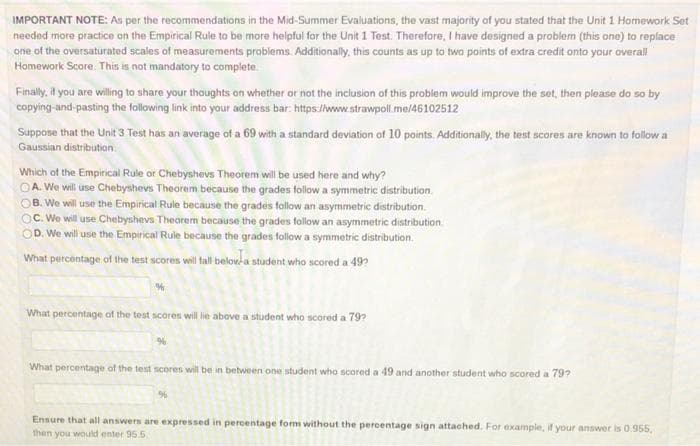IMPORTANT NOTE: As per the recommendations in the Mid-Summer Evaluations, the vast majority of you stated that the Unit 1 Hom needed more practice on the Empirical Rule to be more helpful for the Unit 1 Test. Therefore, I have designed a problem (this one) to one of the oversaturated scales of measurements problems. Additionally, this counts as up to two points of extra credit onto your over Homework Score. This is not mandatory to complete Finally, if you are willing to share your thoughts on whether or not the inclusion of this problem would improve the set, then please do s copying-and-pasting the following link into your address bar: https://www.strawpoll.me/46102512 Suppose that the Unit 3 Test has an average of a 69 with a standard deviation of 10 points. Additionally, the test scores are known to fe Gaussian distribution Which of the Empirical Rule or Chebyshevs Theorem will be used here and why? OA. We will use Chebyshevs Theorem because the grades follow a symmetric distribution B. We will use the Empirical Rule because the grades follow an asymmetric distribution. OC. We will use Chebyshevs Theorem because the grades follow an asymmetric distribution OD. We will use the Empirical Rule because the grades follow a symmetric distribution. What percentage of the test scores will fall below a student who scored a 49? % What percentage of the test scores will lie above a student who scored a 79⁹ % What percentage of the test scores will be in between one student who scored a 49 and another student who scored a 79? % Ensure that all answers are expressed in percentage form without the percentage sign attached. For example, if your answer is 0.9 then you would enter 95.5
IMPORTANT NOTE: As per the recommendations in the Mid-Summer Evaluations, the vast majority of you stated that the Unit 1 Hom needed more practice on the Empirical Rule to be more helpful for the Unit 1 Test. Therefore, I have designed a problem (this one) to one of the oversaturated scales of measurements problems. Additionally, this counts as up to two points of extra credit onto your over Homework Score. This is not mandatory to complete Finally, if you are willing to share your thoughts on whether or not the inclusion of this problem would improve the set, then please do s copying-and-pasting the following link into your address bar: https://www.strawpoll.me/46102512 Suppose that the Unit 3 Test has an average of a 69 with a standard deviation of 10 points. Additionally, the test scores are known to fe Gaussian distribution Which of the Empirical Rule or Chebyshevs Theorem will be used here and why? OA. We will use Chebyshevs Theorem because the grades follow a symmetric distribution B. We will use the Empirical Rule because the grades follow an asymmetric distribution. OC. We will use Chebyshevs Theorem because the grades follow an asymmetric distribution OD. We will use the Empirical Rule because the grades follow a symmetric distribution. What percentage of the test scores will fall below a student who scored a 49? % What percentage of the test scores will lie above a student who scored a 79⁹ % What percentage of the test scores will be in between one student who scored a 49 and another student who scored a 79? % Ensure that all answers are expressed in percentage form without the percentage sign attached. For example, if your answer is 0.9 then you would enter 95.5
A First Course in Probability (10th Edition)
10th Edition
ISBN:9780134753119
Author:Sheldon Ross
Publisher:Sheldon Ross
Chapter1: Combinatorial Analysis
Section: Chapter Questions
Problem 1.1P: a. How many different 7-place license plates are possible if the first 2 places are for letters and...
Related questions
Question

Transcribed Image Text:IMPORTANT NOTE: As per the recommendations in the Mid-Summer Evaluations, the vast majority of you stated that the Unit 1 Homework Set
needed more practice on the Empirical Rule to be more helpful for the Unit 1 Test. Therefore, I have designed a problem (this one) to replace
one of the oversaturated scales of measurements problems. Additionally, this counts as up to two points of extra credit onto your overall
Homework Score. This is not mandatory to complete.
Finally, if you are willing to share your thoughts on whether or not the inclusion of this problem would improve the set, then please do so by
copying-and-pasting the following link into your address bar: https://www.strawpoll.me/46102512
Suppose that the Unit 3 Test has an average of a 69 with a standard deviation of 10 points. Additionally, the test scores are known to follow a
Gaussian distribution
Which of the Empirical Rule or Chebyshevs Theorem will be used here and why?
OA. We will use Chebyshevs Theorem because the grades follow a symmetric distribution
OB. We will use the Empirical Rule because the grades follow an asymmetric distribution.
OC. We will use Chebyshevs Theorem because the grades follow an asymmetric distribution
D. We will use the Empirical Rule because the grades follow a symmetric distribution.
What percentage of the test scores will fall below a student who scored a 49?
%
What percentage of the test scores will lie above a student who scored a 79?
%
What percentage of the test scores will be in between one student who scored a 49 and another student who scored a 79?
%
Ensure that all answers are expressed in percentage form without the percentage sign attached. For example, if your answer is 0.955,
then you would enter 95.5
Expert Solution
This question has been solved!
Explore an expertly crafted, step-by-step solution for a thorough understanding of key concepts.
Step by step
Solved in 2 steps with 1 images

Recommended textbooks for you

A First Course in Probability (10th Edition)
Probability
ISBN:
9780134753119
Author:
Sheldon Ross
Publisher:
PEARSON


A First Course in Probability (10th Edition)
Probability
ISBN:
9780134753119
Author:
Sheldon Ross
Publisher:
PEARSON
